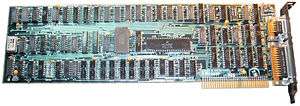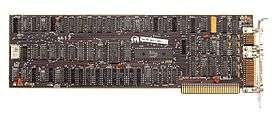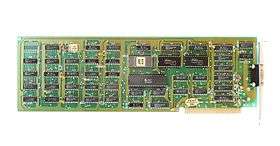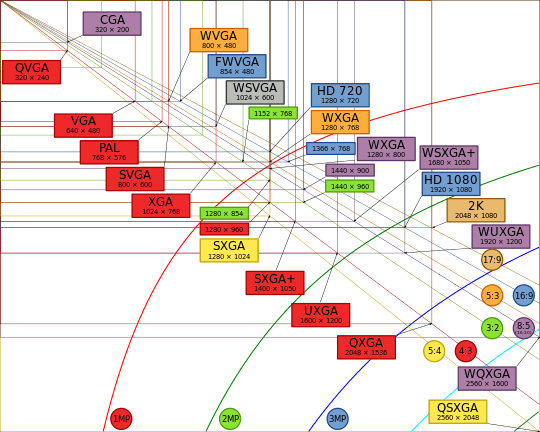IBM Monochrome Display Adapter
 IBM Monochrome Display and Parallel Printer Adapter (MDA) | |
| Release date | 1981 |
|---|---|
| Architecture | Motorola 6845 |
| Cards | |
| Entry-level | IBM MDA, Control Systems Artist 1, Hitachi HD6845SP, UMC UM6845 |
| History | |
| Successor | Hercules Graphics Card, Enhanced Graphics Adapter |



The Monochrome Display Adapter (MDA, also MDA card, Monochrome Display and Printer Adapter, MDPA) is IBM's standard video display card and computer display standard for the PC introduced in 1981. The MDA does not have any pixel-addressable graphics modes. It has only a single monochrome text mode (PC video mode 7), which can display 80 columns by 25 lines of high resolution text characters or symbols useful for drawing forms.
Description
Based on the IBM Datamaster's display system,[1] the standard IBM MDA card is equipped with four kilobytes (kB) of video memory. The MDA's high character resolution (sharpness) is a feature meant to facilitate business and wordprocessing use: Each character is rendered in a box of 9×14 pixels, of which 7×11 depicts the character itself (the other pixels being used for space between character columns and lines). Some characters, such as the lowercase "m", are rendered eight pixels across.
The MDA has the following character display attributes: Invisible, underline, normal, bright (bold), reverse video, and blinking. Some of these attributes can be combined, so that e.g., bright, underlined text can be produced.[2] The theoretical total screen display resolution of the MDA is 720×350 pixels. This number is arrived at through calculating character width (nine pixels) by columns of text (80) and character height (14 pixels) by rows of text (25). However, the MDA cannot address individual pixels; it only works in text mode, limiting its choice of display patterns to 256 characters. The character patterns are stored in ROM on the card and the character set cannot be changed from the hardware code page 437.[2] The only way to simulate "graphical" screen content is through ASCII art.
Because of the lack of pixel-addressable graphics, MDA owners cannot play most graphics-based games. At least one game, IBM's One Hundred And One Monochrome Mazes ("Amazing fun for the whole family"), requires MDA.[3] Code page 437 has 256 characters (0-255), including the standard 95 printable ASCII characters from (32-126), and the 33 ASCII control codes (0-31 and 127) are replaced with printable graphic symbols. It also includes another 128 characters (128-255) like the aforementioned characters for drawing forms. Some of these shapes appear in Unicode as box-drawing characters. The characters are also used in early PC games such as early BBS door games, or games like Castle Adventure by Kevin Bales.
IBM's original MDA includes a parallel printer port (hence its original name of "Monochrome Display and Printer Adapter"), thus avoiding the need for a separate parallel interface on computers fitted with an MDA.
Output capabilities

Text modes:
- 80×25 characters with a 9×14 pixel font (effective resolution of 720×350)
- 4 intensity level combinations (for text and background) for each character cell
Specifications
Connector
Pin numbers (looking at socket):

| Pin | Function |
|---|---|
| 1 | Ground |
| 2 | Ground |
| 3 | Not Used |
| 4 | Not Used |
| 5 | Not Used |
| 6 | Intensity |
| 7 | Video |
| 8 | Horizontal Sync (+) |
| 9 | Vertical Sync (-) |
Signal
| Type | Digital, TTL |
|---|---|
| Resolution | 720h × 350v |
| H-freq | 18.432 kHz |
| V-freq | 50 Hz |
| Colors | 1 |
| Color Intensity | 2-4[5] |
Early boards
Early versions of the MDA board have hardware capable of outputting red, green and blue TTL signals on the normally unconnected video connector pins, theoretically allowing an 8-color display with a suitable monitor. The registers also allow the monochrome mode to be set on and off. No software exists to actually control the feature.[6][7][2]
Clone boards
[2][8] Other boards offer MDA compatibility, although with differences on how attributes are displayed or the font used.
- 3270 PC
- Amstrad PPC / PC20
- Control Systems Artist 1
- Tamarack Microelectronics TD3088A3
Competing adapters
There were two commonly available competing display adapters:
- For PC users requiring bitmapped graphics and/or color, IBM offered its Color Graphics Adapter (CGA, also CGA card), launched at the same time as MDA. CGA was much less popular than MDA at first;[9] the lower resolution of its text mode characters (as compared to MDA) and absence of a printer port, which was included on the original MDA card, made CGA cards less attractive for business use. PC Magazine reported in June 1983 that while "the IBM monochrome display is absolutely beautiful for text and wonderfully easy on the eyes, but is limited to simple character graphics. Text quality on displays connected to the color/graphics adapter ... is at best of medium quality and is conducive to eyestrain over the long haul".[10]
- Introduced in 1982, the non-IBM Hercules Graphics Card offers both an MDA compatible high resolution text mode and a monochrome graphics mode. It can address individual pixels, and display a black and white picture of 720×348 pixels. This resolution is better than even the highest monochrome resolution CGA cards can offer. Thus, even without a color capability of any kind, the Hercules adapter's offer of monochrome graphics without sacrificing MDA-equivalent text quality made it a more desirable choice for many.
- Adapters exist to convert MDA into VGA for upgrading to LCD. Using a GBS-8219 with the video signal (to G) and the horizontal sync (to H/CS) and vertical sync (to V); set to a RGB(D), and Sync Separate(HV).
See also
References
- ↑ Bradley, David J. (September 1990). "The Creation of the IBM PC". BYTE. pp. 414–420. Retrieved 2 April 2016.
- 1 2 3 4 Elliott, John (2005-11-06). "Monochrome Display Adapter: Notes". Archived from the original on 2016-11-23. Retrieved 2016-11-23.
- ↑ Manes, Stephen (1984-01-24). "It's Not Easy Being Green". PC Magazine. p. 391. Retrieved 24 October 2013.
- ↑ IBM Personal Computer Hardware Library: Technical Reference (Revised edition, 1983)
- ↑ There are four possible combinations of values for the 'Intensity' and 'Video' pins, but not all monitors will display them as four distinct intensity levels.
- ↑ Wilton, Richard (1987). Programmer's Guide To PC And PS/2 Video Systems. Microsoft Press. p. 51. ISBN 1-55615-103-9.
- ↑ "IBM 5150 - early version". Minuszerodegrees.net. Retrieved 2014-08-30.
- ↑ http://www.vgamuseum.info/index.php/component/content/article/59-vlasks-articles/index.php?option=com_customproperties&view=show&task=show&cp_made=&cp_bus=&cp_memsize=&cp_year=&cp_memory=&cp_family=&cp_cardtype=mda&cp_owner=&cp_directx=&cp_opengl=&cp_pipelines=&cp_manufacturer=&cp_process=&cp_text_search=
- ↑ Curran, Lawrence J., Shuford, Richard S. (November 1983). "IBM's Estridge". BYTE. pp. 88–97. Retrieved 19 March 2016.
- ↑ Fastie, Will (June 1983). "The Graphical PC". PC Magazine.
